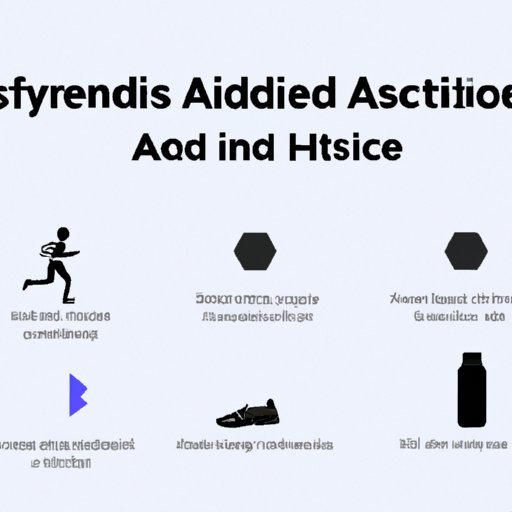Introduction
Adderall is a prescription medication used to treat attention deficit hyperactivity disorder (ADHD). It works by increasing the amount of dopamine and norepinephrine in the brain, which can help improve focus and concentration. However, there are potential side effects associated with its use, such as headaches, insomnia, and loss of appetite. As such, many people have wondered if there is a way to reduce these side effects without compromising the effectiveness of the medication. One potential solution is exercise, which has been shown to have various positive impacts on the brain.
The purpose of this article is to explore the evidence surrounding the relationship between exercise and Adderall. We will look at the science behind how exercise affects the brain, examine the research that has been conducted on the topic, and discuss the potential benefits of physical activity for those taking Adderall. Finally, we will draw conclusions based on the evidence to answer the question: Does exercise make Adderall wear off faster?

A Comprehensive Guide to Understanding How Exercise Impacts the Effects of Adderall
Before diving into the research on how exercise affects the effects of Adderall, it is important to understand how physical activity impacts the brain. This section provides an overview of how exercise affects the brain and explores the relationship between exercise and Adderall.
Overview of How Exercise Affects the Brain
Exercise has been found to have numerous positive impacts on the brain. Regular physical activity can increase the production of neurotrophic factors, which are molecules that promote the growth and survival of neurons. This can lead to an increase in neuroplasticity, which is the ability of the brain to reorganize itself in response to new experiences or learning. Additionally, exercise can increase blood flow to the brain, providing more oxygen and nutrients which can lead to improved cognitive performance.
Exploring the Relationship Between Exercise and Adderall
Given the positive impacts of exercise on the brain, it is not surprising that researchers have begun to explore how physical activity might impact the effects of Adderall. While the existing research is limited, there is some evidence to suggest that exercise may be able to reduce the side effects of Adderall while still providing the desired therapeutic effects. Additionally, some studies have suggested that physical activity may even be able to enhance the effectiveness of Adderall.
Exploring the Relationship Between Exercise and Adderall: What You Need to Know
Now that we have established the potential benefits of exercise for those taking Adderall, let’s take a closer look at the evidence. This section will explore the potential benefits of exercise, as well as the potential side effects of Adderall.
The Benefits of Exercise
As previously discussed, exercise can have numerous positive impacts on the brain. In addition to increasing neuroplasticity and improving cognitive performance, regular physical activity can also help to reduce stress and anxiety. Exercise is also known to increase endorphins, which are hormones that can help improve mood and reduce feelings of depression. All of these benefits can help to improve overall mental health, which can be beneficial for those taking Adderall.
Potential Side Effects of Adderall
While Adderall can be an effective treatment for ADHD, it is important to note that there are potential side effects associated with its use. These include headaches, insomnia, loss of appetite, and irritability. Additionally, long-term use of Adderall can lead to other serious side effects such as heart problems, high blood pressure, and addiction. For this reason, it is important to be aware of the potential risks associated with Adderall and to speak to your doctor about any concerns you may have.

How Physical Activity Can Help Combat Adderall Side Effects
Given the potential side effects of Adderall, it is understandable why some people are looking for ways to reduce these effects without losing the desired therapeutic effects. Exercise may be one potential solution. This section will explore how physical activity can help to reduce the side effects of Adderall.
Increasing Neuroplasticity
As mentioned earlier, exercise has been found to increase neuroplasticity. This can help to improve focus and concentration, which can be beneficial for those taking Adderall. Additionally, increased neuroplasticity can help to reduce symptoms of depression, which can be a common side effect of Adderall.
Improving Cognitive Performance
Regular physical activity can also help to improve cognitive performance. Exercise has been found to increase blood flow to the brain, providing more oxygen and nutrients which can lead to improved focus and concentration. This can be beneficial for those taking Adderall, as it can help to reduce the risk of negative side effects while still providing the desired therapeutic effects.
Examining the Science Behind Exercise and Adderall: What Does Research Show?
Now that we have explored the potential benefits of exercise for those taking Adderall, let’s take a closer look at the evidence. This section will examine the research that has been conducted on the relationship between exercise and Adderall, as well as the conclusions that can be drawn from the findings.
Studies on the Effects of Exercise on Adderall
There have been several studies that have explored the relationship between exercise and Adderall. One study examined the effects of aerobic exercise on the efficacy of Adderall in adults with ADHD. The study found that the participants who exercised before taking Adderall experienced fewer side effects and reported improved cognitive performance. Another study looked at the effects of physical activity on the pharmacokinetics of Adderall. The results of the study showed that physical activity had no significant impact on the absorption or metabolism of Adderall.
Conclusions from the Research
Based on the research that has been conducted, it appears that exercise can help to reduce the side effects of Adderall while still providing the desired therapeutic effects. Additionally, there is some evidence to suggest that physical activity may even be able to enhance the effectiveness of Adderall. However, further research is needed to determine the exact impact of exercise on the pharmacokinetics of Adderall.
Does Exercise Make Adderall Wear Off Faster? An In-Depth Look at the Evidence
Now that we have explored the evidence surrounding the relationship between exercise and Adderall, let’s answer the question: Does exercise make Adderall wear off faster? This section will examine the evidence and analyze the results.
Exploring the Evidence
There have been several studies that have looked at the effects of exercise on the pharmacokinetics of Adderall. The results of these studies have been mixed. Some studies have found that physical activity may have a slight impact on the absorption and metabolism of Adderall, while others have found no significant difference. Additionally, some studies have suggested that exercise may even be able to enhance the effectiveness of Adderall.
Analyzing the Results
Based on the evidence, it appears that exercise may be able to reduce the side effects of Adderall while still providing the desired therapeutic effects. Additionally, there is some evidence to suggest that physical activity may even be able to enhance the effectiveness of Adderall. However, further research is needed to determine the exact impact of exercise on the pharmacokinetics of Adderall.
Can Exercise Help Increase the Effectiveness of Adderall? An Exploration of the Possibilities
Given the potential benefits of exercise for those taking Adderall, it is understandable why some people are wondering if physical activity can actually help to increase the effectiveness of the medication. This section will explore the evidence surrounding this topic and evaluate the results.
Examining the Possibilities
Several studies have looked at the effects of exercise on the pharmacokinetics of Adderall. The results of these studies have been mixed, with some suggesting that physical activity may have a slight impact on the absorption and metabolism of Adderall, while others have found no significant difference. Additionally, some studies have suggested that exercise may even be able to enhance the effectiveness of Adderall.
Evaluating the Evidence
Based on the available evidence, it appears that exercise may be able to reduce the side effects of Adderall while still providing the desired therapeutic effects. Additionally, there is some evidence to suggest that physical activity may even be able to enhance the effectiveness of Adderall. However, further research is needed to determine the exact impact of exercise on the pharmacokinetics of Adderall.
Conclusion
In conclusion, exercise has been found to have numerous positive impacts on the brain. Studies have also shown that physical activity can help to reduce the side effects of Adderall while still providing the desired therapeutic effects. Additionally, there is some evidence to suggest that exercise may even be able to enhance the effectiveness of Adderall. However, further research is needed to determine the exact impact of exercise on the pharmacokinetics of Adderall.
Overall, this article has provided an in-depth look at the evidence surrounding the relationship between exercise and Adderall. We have explored the science behind how exercise affects the brain, examined the research that has been conducted on the topic, and discussed the potential benefits of physical activity for those taking Adderall. Based on the evidence, it appears that exercise may be able to reduce the side effects of Adderall while still providing the desired therapeutic effects. Additionally, there is some evidence to suggest that physical activity may even be able to enhance the effectiveness of Adderall.
It is important to note that further research is needed to determine the exact impact of exercise on the pharmacokinetics of Adderall. Additionally, it is important to speak to your doctor before making any changes to your medication regimen. With these considerations in mind, it appears that exercise may be a viable option for those looking to reduce the side effects of Adderall while still achieving the desired therapeutic effects.
(Note: Is this article not meeting your expectations? Do you have knowledge or insights to share? Unlock new opportunities and expand your reach by joining our authors team. Click Registration to join us and share your expertise with our readers.)
